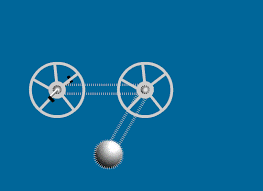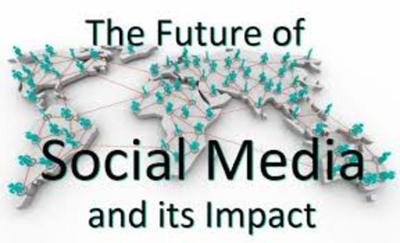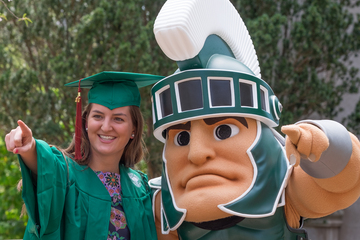We found 115 results that contain "techno"
Posted on: #iteachmsu


Science and technology
Science and technology is a topic that encompasses science, technology, and the interactions between the two. Science is a systematic enterprise that builds and organizes knowledge in the form of explanations and predictions about nature and the universe. Technology is the collection of techniques, methods or processes used in the production of goods or services or in the accomplishment of objectives, such as scientific investigation, or any other consumer demands.
Posted on: #iteachmsu


Incorporating Technologies in the Science Classroom
This playlist is about helping instructors use technology in their classrooms.
Posted on: #iteachmsu


15 Hot New Technologies That Will Change Everything By Christopher Null
The Next Big thing? The memristor, a microscopic component that can "remember" electrical states even when turned off. It's expected to be far cheaper and faster than flash storage. A theoretical concept since 1971, it has now been built in labs and is already starting to revolutionize everything we know
Disciplinary Content
Posted on: #iteachmsu


What Is the Real Impact of Social Media?
Information and communication technology has changed rapidly over the past 20 years with a key development being the emergence of social media.
The pace of change is accelerating. For example, the development of mobile technology has played an important role in shaping the impact of social media. Across the globe, mobile devices dominate in terms of total minutes spent online. This puts the means to connect anywhere, at any time on any device in everyone’s hands.
The pace of change is accelerating. For example, the development of mobile technology has played an important role in shaping the impact of social media. Across the globe, mobile devices dominate in terms of total minutes spent online. This puts the means to connect anywhere, at any time on any device in everyone’s hands.
Assessing Learning
Posted on: Smoke test group : ...


Smoke test: What is Smart Farming? It's The Future of Agriculture -- edited
The Internet of Things (IoT) has provided ways to improve nearly every industry imaginable. In agriculture, IoT has not only provided solutions to often time-consuming and tedious tasks but is totally changing the way we think about agriculture. What exactly is a smart farm, though? Here is a rundown of what smart farming is and how it's changing agriculture.
What is a Smart Farm?
Smart farming refers to managing farms using modern Information and communication technologies to increase the quantity and quality of products while optimizing the human labor required.
Among the technologies available for present-day farmers are:
Sensors: soil, water, light, humidity, temperature management
Software: specialized software solutions that target specific farm types or applications agnostic IoT platforms
Connectivity: cellular, LoRa
Location: GPS, Satellite
Robotics: Autonomous tractors, processing facilities
Data analytics: standalone analytics solutions, data pipelines for downstream solutions -- edited
What is a Smart Farm?
Smart farming refers to managing farms using modern Information and communication technologies to increase the quantity and quality of products while optimizing the human labor required.
Among the technologies available for present-day farmers are:
Sensors: soil, water, light, humidity, temperature management
Software: specialized software solutions that target specific farm types or applications agnostic IoT platforms
Connectivity: cellular, LoRa
Location: GPS, Satellite
Robotics: Autonomous tractors, processing facilities
Data analytics: standalone analytics solutions, data pipelines for downstream solutions -- edited
DISCIPLINARY CONTENT
Posted on: #iteachmsu


32-Core CPUs From Intel and AMD
In the following sections, we outline the basics of 15 upcoming technologies, with predictions on what may come of them. Some are breathing down our necks; some advances are still just out of reach.
Navigating Context
Posted on: Smoke test group on...


Smoke test -- A management information system (MIS) is a system
A management information system (MIS) is a system that collects a company's data and uses it to make more nimble, informed, and impactful business decisions. It's also an academic discipline you can study if you're interested in this type of work. If you enjoy using technology to solve business problems or answer important business questions, then a career in MIS may be a good fit.
Learn more about the benefits of a management information system, key skills you'll need to succeed, and career paths you can pursue. Afterward, if you're interested in building important business
Learn more about the benefits of a management information system, key skills you'll need to succeed, and career paths you can pursue. Afterward, if you're interested in building important business
DISCIPLINARY CONTENT
Posted on: #iteachmsu


Subscriber adding playlist
Lorem Ipsum is simply dummy text of the printing and typesetting industry. Lorem Ipsum has been the industry's standard dummy text ever since the 1500s, when an unknown printer took a galley of type and scrambled it to make a type specimen book. It has survived not only five centuries, but also the leap into electronic typesetting, remaining essentially unchanged.
Posted on: #iteachmsu

About
Teaching Commons: “an emergent conceptual space for exchange and community among faculty, students, and all others committed to learning as an essential activity of life in contemporary democratic society” (Huber and Hutchings, 2005, p.1) What Is the #iteachmsu Commons? You teach MSU. We, the Academic Advancement Network, The Graduate School, and The Hub for Innovation in Learning and Technology, believe that a wide educator community (faculty, TAs, ULAs, instructional designers, academic advisors, et al.) makes learning happen across MSU. But, on such a large campus, it can be difficult to fully recognize and leverage this community’s teaching and learning innovations. To address this challenge, the #iteachmsu Commons provides an educator-driven space for sharing teaching resources, connecting across educator networks, and growing teaching practice. #iteachmsu Commons content may be discipline-specific or transdisciplinary, but will always be anchored in teaching competency areas. You will find blog posts, curated playlists, educator learning module pathways, and a campus-wide teaching and learning events calendar. We cultivate this commons across spaces. And through your engagement, we will continue to nurture a culture of teaching and learning across MSU and beyond. How Do I Contribute to the #iteachmsu Commons? Content is organized by posts, playlists and pathways.
Posts: Posts are shorter or longer-form blog postings about teaching practice(s), questions for the educator community, and/or upcoming teaching and learning events. With an MSU email address and free account signup, educators can immediately contribute blog posts and connected media (e.g. handouts, slide decks, class activity prompts, promotional materials). All educators at MSU are welcome to use and contribute to #iteachmsu. And there are no traditional editorial calendars. Suggested models of posts can be found here.
Playlists: Playlists are groupings of posts curated by individual educators and the #iteachmsu community. Playlists allow individual educators to tailor their development and community experiences based on teaching competency area, interest, and/or discipline.
Pathways: Pathways are groupings of educator learning modules curated by academic and support units for badges and other credentialing.
There are two ways to add your contribution to the space:
Contribute existing local resources for posts and pathways: Your unit, college, and/or department might already have educator development resources that could be of use to the wider MSU teaching and learning community. These could be existing blog posts on teaching practice, teaching webinars, and/or open educational resources (e.g classroom assessments, activities). This content will make up part of the posts, playlists, and pathways on this site. Educators can then curate these posts into playlists based on their individual interests. Please make sure to have permission to share this content on a central MSU web space.
Contribute new content for posts: A strength of the #iteachmsu Commons is that it immediately allows educators to share teaching resources, questions and events through posts to the entire community. Posts can take a variety of forms and are organized by teaching competency area categories, content tags, date, and popularity. Posts can be submitted by both individual educators and central units for immediate posting but must adhere to #iteachmsu Commons community guidelines. Posts could be:
About your teaching practice(s): You discuss and/or reflect on the practices you’re using in your teaching. In addition to talking about your ideas, successes, and challenges, we hope you also provide the teaching materials you used (sharing the assignment, slidedeck, rubric, etc.)
Responses to teaching ideas across the web or social media: You share your thoughts about teaching ideas they engage with from other media across the web (e.g. blog posts, social media posts, etc.).
Cross-posts from other teaching-related blogs that might be useful for the #iteachmsu community: You cross-post content from other teaching-related blogs they feel might be useful to the #iteachmsu community.
About teaching-related events: You share upcoming teaching related events as well as their thoughts about ideas they engage with events at MSU and beyond (e.g. workshops, conferences, etc.). If these events help you think in new ways about your practice, share them with the #iteachmsu community.
Questions for our community: You pose questions via posts to the larger community to get ideas for their practice and connect with others considering similar questions.
What Are the #iteachmsu Commons Policies?Part of the mission of the #iteachmsu Commons is to provide space for sharing, reflecting, and learning for all educators on our campus wherever they are in their teaching development. The commons is designed to encourage these types of interactions and reflect policies outlined by the MSU Faculty Senate. We maintain the right to remove any post that violates guidelines as outlined here and by MSU. To maintain a useful and safer commons, we ask that you:
Follow the MSU Guidelines for Social Media.
Engage across the #iteachmsu commons in a civil and respectful manner. Content may be moderated in accordance with the MSU Guidelines for Social Media.
Do not share private or confidential information via shared content on the #iteachmsu Commons.
Content posted on the #iteachmsu Commons is licensed under a Creative Commons Attribution-NonCommercial-ShareAlike 4.0 International license. Learn more about this licensing here. Posted comments, images, etc. on the #iteachmsu Commons do not necessarily represent the views of Michigan State University or the #iteachmsu Commons Team. Links to external, non-#iteachmsu Commons content do not constitute official endorsement by, or necessarily represent the views of, the #iteachmsu Commons or Michigan State University. What if I Have #iteachmsu Commons Questions and/or Feedback?If you have any concerns about #iteachmsu Commons content, please email us at iteach@msu.edu. We welcome all feedback and thank you for your help in promoting a safer, vibrant and respectful community.
Posts: Posts are shorter or longer-form blog postings about teaching practice(s), questions for the educator community, and/or upcoming teaching and learning events. With an MSU email address and free account signup, educators can immediately contribute blog posts and connected media (e.g. handouts, slide decks, class activity prompts, promotional materials). All educators at MSU are welcome to use and contribute to #iteachmsu. And there are no traditional editorial calendars. Suggested models of posts can be found here.
Playlists: Playlists are groupings of posts curated by individual educators and the #iteachmsu community. Playlists allow individual educators to tailor their development and community experiences based on teaching competency area, interest, and/or discipline.
Pathways: Pathways are groupings of educator learning modules curated by academic and support units for badges and other credentialing.
There are two ways to add your contribution to the space:
Contribute existing local resources for posts and pathways: Your unit, college, and/or department might already have educator development resources that could be of use to the wider MSU teaching and learning community. These could be existing blog posts on teaching practice, teaching webinars, and/or open educational resources (e.g classroom assessments, activities). This content will make up part of the posts, playlists, and pathways on this site. Educators can then curate these posts into playlists based on their individual interests. Please make sure to have permission to share this content on a central MSU web space.
Contribute new content for posts: A strength of the #iteachmsu Commons is that it immediately allows educators to share teaching resources, questions and events through posts to the entire community. Posts can take a variety of forms and are organized by teaching competency area categories, content tags, date, and popularity. Posts can be submitted by both individual educators and central units for immediate posting but must adhere to #iteachmsu Commons community guidelines. Posts could be:
About your teaching practice(s): You discuss and/or reflect on the practices you’re using in your teaching. In addition to talking about your ideas, successes, and challenges, we hope you also provide the teaching materials you used (sharing the assignment, slidedeck, rubric, etc.)
Responses to teaching ideas across the web or social media: You share your thoughts about teaching ideas they engage with from other media across the web (e.g. blog posts, social media posts, etc.).
Cross-posts from other teaching-related blogs that might be useful for the #iteachmsu community: You cross-post content from other teaching-related blogs they feel might be useful to the #iteachmsu community.
About teaching-related events: You share upcoming teaching related events as well as their thoughts about ideas they engage with events at MSU and beyond (e.g. workshops, conferences, etc.). If these events help you think in new ways about your practice, share them with the #iteachmsu community.
Questions for our community: You pose questions via posts to the larger community to get ideas for their practice and connect with others considering similar questions.
What Are the #iteachmsu Commons Policies?Part of the mission of the #iteachmsu Commons is to provide space for sharing, reflecting, and learning for all educators on our campus wherever they are in their teaching development. The commons is designed to encourage these types of interactions and reflect policies outlined by the MSU Faculty Senate. We maintain the right to remove any post that violates guidelines as outlined here and by MSU. To maintain a useful and safer commons, we ask that you:
Follow the MSU Guidelines for Social Media.
Engage across the #iteachmsu commons in a civil and respectful manner. Content may be moderated in accordance with the MSU Guidelines for Social Media.
Do not share private or confidential information via shared content on the #iteachmsu Commons.
Content posted on the #iteachmsu Commons is licensed under a Creative Commons Attribution-NonCommercial-ShareAlike 4.0 International license. Learn more about this licensing here. Posted comments, images, etc. on the #iteachmsu Commons do not necessarily represent the views of Michigan State University or the #iteachmsu Commons Team. Links to external, non-#iteachmsu Commons content do not constitute official endorsement by, or necessarily represent the views of, the #iteachmsu Commons or Michigan State University. What if I Have #iteachmsu Commons Questions and/or Feedback?If you have any concerns about #iteachmsu Commons content, please email us at iteach@msu.edu. We welcome all feedback and thank you for your help in promoting a safer, vibrant and respectful community.
Posted by: Scarlet Ethan Edien
Posted on: Smoke test group on...


Smoke test -- management information system (MIS)
A management information system (MIS) is a system that collects a company's data and uses it to make more nimble, informed, and impactful business decisions. It's also an academic discipline you can study if you're interested in this type of work. If you enjoy using technology to solve business problems or answer important business questions, then a career in MIS may be a good fit.
Learn more about the benefits of a management information system, key skills you'll need to succeed, and career paths you can pursue. Afterward, if you're interested in building important business
Learn more about the benefits of a management information system, key skills you'll need to succeed, and career paths you can pursue. Afterward, if you're interested in building important business
Authored by: vijaya
Posted on: Smoke test group : ...


Smoke test: What is Smart Farming? It's The Future of Agriculture -- edited
The Internet of Things (IoT) has provided ways to improve nearly every industry imaginable. In agriculture, IoT has not only provided solutions to often time-consuming and tedious tasks but is totally changing the way we think about agriculture. What exactly is a smart farm, though? Here is a rundown of what smart farming is and how it's changing agriculture.
What is a Smart Farm?
Smart farming refers to managing farms using modern Information and communication technologies to increase the quantity and quality of products while optimizing the human labor required.
Among the technologies available for present-day farmers are:
Sensors: soil, water, light, humidity, temperature management
Software: specialized software solutions that target specific farm types or applications agnostic IoT platforms
Connectivity: cellular, LoRa
Location: GPS, Satellite
Robotics: Autonomous tractors, processing facilities
Data analytics: standalone analytics solutions, data pipelines for downstream solutions
What is a Smart Farm?
Smart farming refers to managing farms using modern Information and communication technologies to increase the quantity and quality of products while optimizing the human labor required.
Among the technologies available for present-day farmers are:
Sensors: soil, water, light, humidity, temperature management
Software: specialized software solutions that target specific farm types or applications agnostic IoT platforms
Connectivity: cellular, LoRa
Location: GPS, Satellite
Robotics: Autonomous tractors, processing facilities
Data analytics: standalone analytics solutions, data pipelines for downstream solutions
Posted by: Scarlet Ethan Edien
Justice and Belonging
Posted on: #iteachmsu


Getting Started
What is the #iteachmsu Commons?
Welcome to the #iteachmsu Commons
You teach MSU. We, the Academic Advancement Network, The Graduate School, and The Hub for Innovation in Learning and Technology, believe that a wide educator community (faculty, TAs, ULAs, instructional designers, academic advisors, et al.) makes learning happen across MSU. But, on such a large campus, it can be difficult to fully recognize and leverage this community’s teaching and learning innovations. To address this challenge, the #iteachmsu Commons provides an educator-driven space for sharing teaching resources, connecting across educator networks, and growing teaching practice.
#iteachmsu Commons content may be discipline-specific or transdisciplinary, but will always be anchored in teaching competency areas. You will find short posts, blog-like articles, curated playlists, and a campus-wide teaching and learning events calendar. We cultivate this commons across spaces. And through your engagement, we will continue to nurture a culture of teaching and learning across MSU and beyond.
How to login
To begin creating content of your own on the #iteachmsu Commons, simply click the green Login button in the upper right hand corner of the screen. Your account will automatically be provisioned after successfully logging into the MSU Net ID login prompt. Currently, only authenticated MSU faculty, staff and students can create content on the #iteachmsu Commons. However, external users are free to browse and share public facing content without logging into the site.
Where to start
If you are looking for brief instructive videos on the core functionality of the site, take a look at our Getting Started playlist. After viewing each one of the video tutorials on the playlist, you will receive a Contributor badge which will display on your profile
What Are the #iteachmsu Commons Policies?
Part of the mission of the #iteachmsu Commons is to provide space for sharing, reflecting, and learning for all educators on our campus wherever they are in their teaching development. The commons is designed to encourage these types of interactions and reflect policies outlined by the MSU Faculty Senate. We maintain the right to remove any post that violates guidelines as outlined here and by MSU. To maintain a useful and safer commons, we ask that you:
Follow the MSU Guidelines for Social Media.
Engage across the #iteachmsu commons in a civil and respectful manner. Content may be moderated in accordance with the MSU Guidelines for Social Media.Do not share private or confidential information via shared content on the #iteachmsu Commons.
Content posted on the #iteachmsu Commons is licensed under a Creative Commons Attribution-NonCommercial-ShareAlike 4.0 International license. Learn more about this licensing here. Posted comments, images, etc. on the #iteachmsu Commons do not necessarily represent the views of Michigan State University or the #iteachmsu Commons Team. Links to external, non-#iteachmsu Commons content do not constitute official endorsement by, or necessarily represent the views of, the #iteachmsu Commons or Michigan State University.
Other important policies:
MSU's Web Accessibility Statement
MSU's Privacy Statement
What if I Have #iteachmsu Commons Questions and/or Feedback?
If you have any concerns about #iteachmsu Commons content, please email us at iteach@msu.edu. We welcome all feedback and thank you for your help in promoting a safer, vibrant and respectful community.
Stay up to date with the #iteachmsu Digest
Welcome to the #iteachmsu Commons
You teach MSU. We, the Academic Advancement Network, The Graduate School, and The Hub for Innovation in Learning and Technology, believe that a wide educator community (faculty, TAs, ULAs, instructional designers, academic advisors, et al.) makes learning happen across MSU. But, on such a large campus, it can be difficult to fully recognize and leverage this community’s teaching and learning innovations. To address this challenge, the #iteachmsu Commons provides an educator-driven space for sharing teaching resources, connecting across educator networks, and growing teaching practice.
#iteachmsu Commons content may be discipline-specific or transdisciplinary, but will always be anchored in teaching competency areas. You will find short posts, blog-like articles, curated playlists, and a campus-wide teaching and learning events calendar. We cultivate this commons across spaces. And through your engagement, we will continue to nurture a culture of teaching and learning across MSU and beyond.
How to login
To begin creating content of your own on the #iteachmsu Commons, simply click the green Login button in the upper right hand corner of the screen. Your account will automatically be provisioned after successfully logging into the MSU Net ID login prompt. Currently, only authenticated MSU faculty, staff and students can create content on the #iteachmsu Commons. However, external users are free to browse and share public facing content without logging into the site.
Where to start
If you are looking for brief instructive videos on the core functionality of the site, take a look at our Getting Started playlist. After viewing each one of the video tutorials on the playlist, you will receive a Contributor badge which will display on your profile
What Are the #iteachmsu Commons Policies?
Part of the mission of the #iteachmsu Commons is to provide space for sharing, reflecting, and learning for all educators on our campus wherever they are in their teaching development. The commons is designed to encourage these types of interactions and reflect policies outlined by the MSU Faculty Senate. We maintain the right to remove any post that violates guidelines as outlined here and by MSU. To maintain a useful and safer commons, we ask that you:
Follow the MSU Guidelines for Social Media.
Engage across the #iteachmsu commons in a civil and respectful manner. Content may be moderated in accordance with the MSU Guidelines for Social Media.Do not share private or confidential information via shared content on the #iteachmsu Commons.
Content posted on the #iteachmsu Commons is licensed under a Creative Commons Attribution-NonCommercial-ShareAlike 4.0 International license. Learn more about this licensing here. Posted comments, images, etc. on the #iteachmsu Commons do not necessarily represent the views of Michigan State University or the #iteachmsu Commons Team. Links to external, non-#iteachmsu Commons content do not constitute official endorsement by, or necessarily represent the views of, the #iteachmsu Commons or Michigan State University.
Other important policies:
MSU's Web Accessibility Statement
MSU's Privacy Statement
What if I Have #iteachmsu Commons Questions and/or Feedback?
If you have any concerns about #iteachmsu Commons content, please email us at iteach@msu.edu. We welcome all feedback and thank you for your help in promoting a safer, vibrant and respectful community.
Stay up to date with the #iteachmsu Digest
Authored by: Admin #iteachmsu
Navigating Context
Posted on: #iteachmsu


Choosing a Time Management Technique That Works for You -- Additionally added
Whether you’re a full-time student, a working student or a parent going back to school, better time management skills are vital to living a balanced life. If you have a habit of leaving things until the last minute, try using Parkinson’s Law or the eat that frog method. If you have a hard time focusing on the task at hand, try the Pomodoro technique of working more intensely in short intervals.Mastering time management will set you up for success in all areas of your life and will help you avoid test anxiety when finals roll around. At USAHS, we emphasize supporting our students in their personal and professional lives. We help you develop the tools and additional resources you need to succeed in our graduate degree programs.
Posted by: Venturit Super Admin
Posted on: #iteachmsu

Heart attack symptoms
Embedded video URL:
Symptoms -- Editing
Symptoms of a heart attack vary. Some people have mild symptoms. Others have severe symptoms. Some people have no symptoms.
Common heart attack symptoms include:
Chest pain that may feel like pressure, tightness, pain, squeezing or aching
Pain or discomfort that spreads to the shoulder, arm, back, neck, jaw, teeth or sometimes the upper belly
Cold sweat
Fatigue
Heartburn or indigestion
Lightheadedness or sudden dizziness
Nausea
Shortness of breath
Women may have atypical symptoms such as brief or sharp pain felt in the neck, arm or back. Sometimes, the first symptom sign of a heart attack is sudden cardiac arrest.
Some heart attacks strike suddenly. But many people have warning signs and symptoms hours, days or weeks in advance. Chest pain or pressure (angina) that keeps happening and doesn't go away with rest may be an early warning sign. Angina is caused by a temporary decrease in blood flow to the heart.
Symptoms
Symptoms of a heart attack vary. Some people have mild symptoms. Others have severe symptoms. Some people have no symptoms.
Common heart attack symptoms include:
Chest pain that may feel like pressure, tightness, pain, squeezing or aching
Pain or discomfort that spreads to the shoulder, arm, back, neck, jaw, teeth or sometimes the upper belly
Cold sweat
Fatigue
Heartburn or indigestion
Lightheadedness or sudden dizziness
Nausea
Shortness of breath
Women may have atypical symptoms such as brief or sharp pain felt in the neck, arm or back. Sometimes, the first symptom sign of a heart attack is sudden cardiac arrest.
Some heart attacks strike suddenly. But many people have warning signs and symptoms hours, days or weeks in advance. Chest pain or pressure (angina) that keeps happening and doesn't go away with rest may be an early warning sign. Angina is caused by a temporary decrease in blood flow to the heart.
Symptoms -- Editing
Symptoms of a heart attack vary. Some people have mild symptoms. Others have severe symptoms. Some people have no symptoms.
Common heart attack symptoms include:
Chest pain that may feel like pressure, tightness, pain, squeezing or aching
Pain or discomfort that spreads to the shoulder, arm, back, neck, jaw, teeth or sometimes the upper belly
Cold sweat
Fatigue
Heartburn or indigestion
Lightheadedness or sudden dizziness
Nausea
Shortness of breath
Women may have atypical symptoms such as brief or sharp pain felt in the neck, arm or back. Sometimes, the first symptom sign of a heart attack is sudden cardiac arrest.
Some heart attacks strike suddenly. But many people have warning signs and symptoms hours, days or weeks in advance. Chest pain or pressure (angina) that keeps happening and doesn't go away with rest may be an early warning sign. Angina is caused by a temporary decrease in blood flow to the heart.
Symptoms
Symptoms of a heart attack vary. Some people have mild symptoms. Others have severe symptoms. Some people have no symptoms.
Common heart attack symptoms include:
Chest pain that may feel like pressure, tightness, pain, squeezing or aching
Pain or discomfort that spreads to the shoulder, arm, back, neck, jaw, teeth or sometimes the upper belly
Cold sweat
Fatigue
Heartburn or indigestion
Lightheadedness or sudden dizziness
Nausea
Shortness of breath
Women may have atypical symptoms such as brief or sharp pain felt in the neck, arm or back. Sometimes, the first symptom sign of a heart attack is sudden cardiac arrest.
Some heart attacks strike suddenly. But many people have warning signs and symptoms hours, days or weeks in advance. Chest pain or pressure (angina) that keeps happening and doesn't go away with rest may be an early warning sign. Angina is caused by a temporary decrease in blood flow to the heart.
Posted by: Venturit Super Admin
Posted on: #iteachmsu


By Chathu: Fish Farming article
Fish farming is an ideal business idea for investors with available land, and it doesn’t always require a large body of water. You can start a fish farm either by creating fish ponds or investing in fish tanks; it’s a highly scalable business idea. Once you have the proper knowledge of fish raising, you will be able to decide the type of fish to raise. According to FinModelsLab, a well-run fish farm can produce a return on investment (ROI) of 15% to 40% annually, with many fish farmers achieving a full return on their investment within three to five years.
Fish such as tilapia, cod, trout, and catfish are popular because they are easy to raise and in high demand. Small-scale farms are the usual suppliers of fish in their local supermarkets and restaurants.
Other popular varieties of commercially-raised fish include:
Yellow Perch
Eel
Grass Carp
Tuna
Salmon
Not all fish are raised for food. Goldfish and koi are popular fish to farm as well. For non-food fish, focus on cultivating premium species that will fetch a higher price when you sell. Whether you are raising fish for food or not, adopting sustainable farming practices will be better for both your business branding and your long-term operational costs.
The decision as to which fish you want to raise will ultimately rely on your skill, financial capacity, market demand, and agro-climatic condition. This refers to the normal soil types, rainfall, temperature, and water availability that affect the type of vegetation in the area.
Fish such as tilapia, cod, trout, and catfish are popular because they are easy to raise and in high demand. Small-scale farms are the usual suppliers of fish in their local supermarkets and restaurants.
Other popular varieties of commercially-raised fish include:
Yellow Perch
Eel
Grass Carp
Tuna
Salmon
Not all fish are raised for food. Goldfish and koi are popular fish to farm as well. For non-food fish, focus on cultivating premium species that will fetch a higher price when you sell. Whether you are raising fish for food or not, adopting sustainable farming practices will be better for both your business branding and your long-term operational costs.
The decision as to which fish you want to raise will ultimately rely on your skill, financial capacity, market demand, and agro-climatic condition. This refers to the normal soil types, rainfall, temperature, and water availability that affect the type of vegetation in the area.
Posted by: Chathuri Hewapathirana 1
Posted on: #iteachmsu


Parent group article by admin: Key aspects of API testing:
Direct interaction:
API tests send requests directly to API endpoints and analyze the responses to ensure they meet expected outcomes.This involves checking status codes, response times, and the structure and content of the data returned.
Focus on business logic:
API testing primarily validates the underlying business rules and data flow within an application, independent of the user interface.
Early defect detection:
By testing APIs early in the development lifecycle, issues can be identified and resolved before they become more complex and costly to fix in later stages.
Automation potential:
API tests are highly automatable, allowing for frequent and efficient execution, which is crucial for continuous integration and continuous delivery (CI/CD) pipelines.
Types of API tests:
This can include functional testing (verifying core functionality), performance testing (measuring response times under load), security testing (identifying vulnerabilities), and integration testing (ensuring seamless communication between APIs and external services).
API tests send requests directly to API endpoints and analyze the responses to ensure they meet expected outcomes.This involves checking status codes, response times, and the structure and content of the data returned.
Focus on business logic:
API testing primarily validates the underlying business rules and data flow within an application, independent of the user interface.
Early defect detection:
By testing APIs early in the development lifecycle, issues can be identified and resolved before they become more complex and costly to fix in later stages.
Automation potential:
API tests are highly automatable, allowing for frequent and efficient execution, which is crucial for continuous integration and continuous delivery (CI/CD) pipelines.
Types of API tests:
This can include functional testing (verifying core functionality), performance testing (measuring response times under load), security testing (identifying vulnerabilities), and integration testing (ensuring seamless communication between APIs and external services).
Posted by: Admin
Posted on: Smoke test group : ...


Smoke test: The Internet of Things (IoT) has provided ways to improve nearly every industry imaginable. In agriculture, IoT has not only provided solutions to often time-consuming and tedious tasks but is totally changing the way we think about agriculture. What exactly is a smart farm, though? Here is a rundown of what smart farming is and how it's changing agriculture.
What is a Smart Farm?
Smart farming refers to managing farms using modern Information and communication technologies to increase the quantity and quality of products while optimizing the human labor required.
Among the technologies available for present-day farmers are:
Sensors: soil, water, light, humidity, temperature management
Software: specialized software solutions that target specific farm types or applications agnostic IoT platforms
Connectivity: cellular, LoRa
Location: GPS, Satellite
Robotics: Autonomous tractors, processing facilities
Data analytics: standalone analytics solutions, data pipelines for downstream solutions -- edited
What is a Smart Farm?
Smart farming refers to managing farms using modern Information and communication technologies to increase the quantity and quality of products while optimizing the human labor required.
Among the technologies available for present-day farmers are:
Sensors: soil, water, light, humidity, temperature management
Software: specialized software solutions that target specific farm types or applications agnostic IoT platforms
Connectivity: cellular, LoRa
Location: GPS, Satellite
Robotics: Autonomous tractors, processing facilities
Data analytics: standalone analytics solutions, data pipelines for downstream solutions -- edited
Posted by: Scarlet Ethan Edien
Posted on: #iteachmsu

Edited -- A natural disaster is the highly harmful impact on a society or community following a natural hazard event. The term "disaster" itself is defined as follows: "Disasters are serious disruptions to the functioning of a community that exceed its capacity to cope using its own resources. Disasters can be caused by natural, man-made and technological hazards, as well as various factors that influence the exposure and vulnerability of a community."[17]
The US Federal Emergency Management Agency (FEMA) explains the relationship between natural disasters and natural hazards as follows: "Natural hazards and natural disasters are related but are not the same. A natural hazard is the threat of an event that will likely have a negative impact. A natural disaster is the negative impact following an actual occurrence of natural hazard in the event that it significantly harms a community.[1] An example of the distinction between a natural hazard and a disaster is that an earthquake is the hazard which caused the 1906 San Francisco earthquake disaster.
A natural hazard[18] is a natural phenomenon that might have a negative effect on humans and other animals, or the environment. Natural hazard events can be classified into two broad categories: geophysical and biological.[19] Natural hazards can be provoked or affected by anthropogenic processes, e.g. land-use change, drainage and construction.[20]
There are 18 natural hazards included in the National Risk Index of FEMA: avalanche, coastal flooding, cold wave, drought, earthquake, hail, heat wave, tropical cyclone, ice storm, landslide, lightning, riverine flooding, strong wind, tornado, tsunami, volcanic activity, wildfire, winter weather.[1] In addition there are also tornados and dust storms.
The US Federal Emergency Management Agency (FEMA) explains the relationship between natural disasters and natural hazards as follows: "Natural hazards and natural disasters are related but are not the same. A natural hazard is the threat of an event that will likely have a negative impact. A natural disaster is the negative impact following an actual occurrence of natural hazard in the event that it significantly harms a community.[1] An example of the distinction between a natural hazard and a disaster is that an earthquake is the hazard which caused the 1906 San Francisco earthquake disaster.
A natural hazard[18] is a natural phenomenon that might have a negative effect on humans and other animals, or the environment. Natural hazard events can be classified into two broad categories: geophysical and biological.[19] Natural hazards can be provoked or affected by anthropogenic processes, e.g. land-use change, drainage and construction.[20]
There are 18 natural hazards included in the National Risk Index of FEMA: avalanche, coastal flooding, cold wave, drought, earthquake, hail, heat wave, tropical cyclone, ice storm, landslide, lightning, riverine flooding, strong wind, tornado, tsunami, volcanic activity, wildfire, winter weather.[1] In addition there are also tornados and dust storms.
Posted by: Derek Matin 935
Disciplinary Content
Posted on: Smoke test group on...


Smoke test -- A management information system (MIS) is a system that collects a company's data and uses it to make more nimble, informed, and impactful business decisions. It's also an academic discipline you can study if you're interested in this type of work. If you enjoy using technology to solve business problems or answer important business questions, then a career in MIS may be a good fit.
Learn more about the benefits of a management information system, key skills you'll need to succeed, and career paths you can pursue. Afterward, if you're interested in building important business
Learn more about the benefits of a management information system, key skills you'll need to succeed, and career paths you can pursue. Afterward, if you're interested in building important business
Posted by: Scarlet Ethan Edien
Navigating Context
Posted on: Try to leave negati...


Practice Gratitude
This final tip is the easiest one of all: be grateful! Try to leave negativity at the door and focus on all the good things you do have. It’s been shown that positive people live longer. Just like a healthy diet, filling your life with positive people, thoughts and things can have long-lasting positive impacts on your longevity. -- edited
This final tip is the easiest one of all: be grateful! Try to leave negativity at the door and focus on all the good things you do have. It’s been shown that positive people live longer. Just like a healthy diet, filling your life with positive people, thoughts and things can have long-lasting positive impacts on your longevity. -- edited
Posted by: Derek Matin 935
Posted on: Why choose agile? G...


Teams choose agile so they can respond to changes in the marketplace or feedback from customers quickly without derailing a year's worth of plans. "Just enough" planning and shipping in small, frequent increments lets your team gather feedback on each change and integrate it into future plans at minimal cost.
But it's not just a numbers game—first and foremost, it's about people. As described by the Agile Manifesto, authentic human interactions are more important than rigid processes. Collaborating with customers and teammates is more important than predefined arrangements. And delivering a working solution to the customer's problem is more important than hyper-detailed documentation.
An agile team unites under a shared vision, then brings it to life the way they know is best. Each team sets their own standards for quality, usability, and completeness. Their "definition of done" then informs how fast they'll churn the work out. Although it can be scary at first, company leaders find that when they put their trust in an agile team, that team feels a greater sense of ownership and rises to meet (or exceed) management's expectations.
But it's not just a numbers game—first and foremost, it's about people. As described by the Agile Manifesto, authentic human interactions are more important than rigid processes. Collaborating with customers and teammates is more important than predefined arrangements. And delivering a working solution to the customer's problem is more important than hyper-detailed documentation.
An agile team unites under a shared vision, then brings it to life the way they know is best. Each team sets their own standards for quality, usability, and completeness. Their "definition of done" then informs how fast they'll churn the work out. Although it can be scary at first, company leaders find that when they put their trust in an agile team, that team feels a greater sense of ownership and rises to meet (or exceed) management's expectations.
Posted by: Derek Matin 935
Posted on: 12 Best API Testing...

ACCELQ offers API chaining and regression suite capabilities for mature API testing. This test automation platform achieves end-to-end validations with API and UI in the same flow. API testing with this platform brings regression maturity. You can easily reuse and chain your API tests for integrated automation. Most importantly, programming is not required to build the API regression suite. ACCELQ ensures 360° quality test coverage by seamlessly embedding critical server-side API validations and your front-end testing.
Features:
ACCELQ includes API verifications with a simple and natural interface.
REST, SOAP, and custom protocols are supported for complete API testing.
Codeless to automate API tests on the Cloud in the same simplified flow.
ACCELQ supports API test case management, test planning, execution, and tracking governance.
In-sprint automation with seamless API automation is supported.
ACCELQ chains API tests for true end-to-end validation.
Supports integrated CI workflow to trigger automated API suite regression.
ACCELQ supports simple and automated change impact analysis of the API test suite.
Execution tracking of API tests with full visibility and defect-tracking integrations are supported.
Dynamic live results view with actionable reports to trigger reruns.
ACCELQ restricts application access via Oauth 2.0-based security and tenant group access policies.
Features:
ACCELQ includes API verifications with a simple and natural interface.
REST, SOAP, and custom protocols are supported for complete API testing.
Codeless to automate API tests on the Cloud in the same simplified flow.
ACCELQ supports API test case management, test planning, execution, and tracking governance.
In-sprint automation with seamless API automation is supported.
ACCELQ chains API tests for true end-to-end validation.
Supports integrated CI workflow to trigger automated API suite regression.
ACCELQ supports simple and automated change impact analysis of the API test suite.
Execution tracking of API tests with full visibility and defect-tracking integrations are supported.
Dynamic live results view with actionable reports to trigger reruns.
ACCELQ restricts application access via Oauth 2.0-based security and tenant group access policies.
Posted by: Scarlet Ethan Edien
Posted on: #iteachmsu


Peer tutoring is most effective when training is provided to participating students (Piffner, 2011). Tutors need to be taught how to be prepared with materials needed for the session and how
to give positive and corrective feedback to their partner (Greenwood & Delquadri,
1995).
to give positive and corrective feedback to their partner (Greenwood & Delquadri,
1995).
Posted by: Venturit Super Admin
Posted on: Educator Development

AI in Qualitative Research: ChatGPT vs. Human Coders
An MSU study examined ChatGPT’s role in qualitative data analysis, comparing AI-augmented and human coding of hotel guest experiences. AI-generated themes aligned with human-coded ones but missed social interactions and safety concerns. A hybrid approach—AI for initial coding with human refinement—balances efficiency and analytical rigor.
An MSU study examined ChatGPT’s role in qualitative data analysis, comparing AI-augmented and human coding of hotel guest experiences. AI-generated themes aligned with human-coded ones but missed social interactions and safety concerns. A hybrid approach—AI for initial coding with human refinement—balances efficiency and analytical rigor.
Posted by: Jhon Carlos
Host: #iteachmsu


Cloud Computing
Cloud Computing provides us means by which we can access the applications as utilities over the internet. It allows us to create, configure, and customize the business applications online.
Before deploying applications to cloud, it is necessary to consider your business requirements. Following are the issues one must consider:
Data Security and Privacy Requirement
Budget Requirements
Type of cloud - public, private or hybrid
Data backup requirements
Training requirements
Dashboard and reporting requirements
Client access requirements
Data export requirements
To meet all of these requirements, it is necessary to have well-compiled planning. In this tutorial, we will discuss the various planning phases that must be practised by an enterprise before migrating the entire business to cloud. Each of these planning phases are described in the following diagram:
Cloud Computing Planning
Strategy Phase
In this phase, we analyze the strategy problems that customer might face. There are two steps to perform this analysis:
Cloud Computing Value Proposition
Cloud Computing Strategy Planning
Cloud Computing Value Proposition
In this, we analyze the factors influencing the customers when applying cloud computing mode and target the key problems they wish to solve. These key factors are:
IT
Host: #iteachmsu


Cloud Computing
Cloud Computing provides us means by which we can access the applications as utilities over the internet. It allows us to create, configure, and customize the business applications online.
Before deploying applications to cloud, it is necessary to consider your business requirements. Following are the issues one must consider:
Data Security and Privacy Requirement
Budget Requirements
Type of cloud - public, private or hybrid
Data backup requirements
Training requirements
Dashboard and reporting requirements
Client access requirements
Data export requirements
To meet all of these requirements, it is necessary to have well-compiled planning. In this tutorial, we will discuss the various planning phases that must be practised by an enterprise before migrating the entire business to cloud. Each of these planning phases are described in the following diagram:
Cloud Computing Planning
Strategy Phase
In this phase, we analyze the strategy problems that customer might face. There are two steps to perform this analysis:
Cloud Computing Value Proposition
Cloud Computing Strategy Planning
Cloud Computing Value Proposition
In this, we analyze the factors influencing the customers when applying cloud computing mode and target the key problems they wish to solve. These key factors are:
IT
EXPIRED
Host: CTLI

Make It Count: High-Impact Assessment Feedback in Less Time
This workshop explores strategies for providing feedback that enhances student learning while helping you manage grading time. Participants will learn how to deliver intentional, elaborative feedback and how to prioritize higher-order concerns in written assignments. The session will also introduce educational technology tools and assessment strategies designed to streamline the feedback process. By the end, attendees will walk away with practical techniques to support student growth without increasing workload.
Upon completion of this learning experience, participants will be able to:
describe the role of feedback in promoting student learning
explain the benefits of providing students with intentional, elaborative feedback on multiple-choice questions (MCQs)
differentiate between higher-order and lower-order concerns in feedback on assignments
identify assessment strategies and educational technology tools that assist in time management when providing feedback.
Navigating Context
EXPIRED
Host: CTLI

Navigating D2L Functions as GTAs: Q&A
On behalf of the GREAT office at The Graduate School, check out Navigating D2L Functions as GTAs: Q&A
Date: Thursday, August 28, 2025 - 1:00pm to 2:00pm
Location: Zoom
Audience: Current Graduate Students & Postdocs
You are in a new Graduate Teaching Assistant role and have started working with D2L, and as you do so, questions about various functions and use of these arise. This workshop is a Q & A session with MSU IT experts on D2L, Gradebook, Accessibility Checker, Checklists, etc. Join us if you have any questions and need assistance as you navigate the Learning Management System as GTA.
Facilitators: Cui Cheng (Instructional Designer, MSU IT Educational Technology) and Jennie Wagner (Instructional Designer, MSU IT Educational Technology)
Zoom link will be sent closer to the workshop date.
Register Here
Navigating Context
EXPIRED
Host: MSU Libraries

Annual Digital Humanities THATCamp 2025
Greetings from the MSU Digital Humanities Community!
Please share the following invitation with your faculty colleagues, students, and staff.
We would like to invite you and your colleagues to join us for the annual Digital Humanities THATCamp, taking place on Thursday, August 21st from 8:30AM - 3:00PM in the Digital Scholarship Lab of the MSU Main Library (Second Floor, West).
*Light breakfast, lunch will be served. Please join us for an Ice Cream Social from 3:15PM-4:30PM. Location outdoors, TBD.
Please register here.
What is THATCamp?
THATCamp stands for “The Humanities and Technology Camp.” It is an unconference: an open, less formal meeting where humanists and technologists of all skill levels learn and build together in sessions proposed on the spot (From: http://thatcamp.org/about).
Who is THATCamp for?
This day-long, in person, fun, unconference is a fantastic opportunity for people on campus, whether formally a part of the DH@MSU community or not, to gather, learn from each other, and make connections to carry forward into the academic year. We welcome:
Members of the DH@MSU community, old and new
Students in the Digital Humanities undergraduate minor or graduate certificate, and students interested in the minor/certificate
Humanists who are engaged in digital and computer-assisted research, teaching, and creation
Anyone doing or interested in exploring work in the digital, especially (but not exclusively) in the areas of arts, humanities, and social sciences
Why THATCamp MSU?
DH@MSU is continuing our annual THATCamp each August targeted at MSU faculty, staff, and students for a few reasons:
To bring people back together after the summer
To introduce new folks to the DH@MSU community
Share knowledge, expertise, and skills among the community
Build connections between community members for future collaborations, troubleshooting, and ice cream social time.
THATCamp is FREE! Please register here.
Please direct any questions to Max Evjen (evjendav@msu.edu).
Navigating Context
EXPIRED
Host: CTLI

Setting the Tone from the Start
The way a course begins is crucial for educators to establish an environment that fosters engagement, collaboration, and a sense of belonging. Join us for a one-hour hybrid workshop where Educator Developers with MSU's Center for Teaching and Learning Innovation will share actionable strategies that lay the groundwork for an engaging and inclusive course experience from day one including items related to syllabi, expectation setting and pedagogical transparency, checking in on learner needs throughout the term, and way to build a sense of classroom community.
In this workshop, we'll delve into practical techniques and approaches educators can employ to create a welcoming and motivating atmosphere that resonates with learners. The content in this workshop will be primarily targeted to classroom instructors and settings, but tools and strategies are relevant for adaptation and use by any educator in any context. Whether you're a seasoned educator or just embarking on your teaching journey this academic year, "Setting the Tone from the Start" is designed to equip you with actionable insights that will make a difference in your classroom.
Upon completion of this learning experience, participants will be able to:
learn how to craft an engaging and purposeful course introduction that communicates the course's relevance, objectives, and expectations
discover techniques for fostering an inclusive and supportive learning community, understanding how to encourage peer connections and embrace diverse viewpoints
be equipped with a range of interactive strategies, including icebreakers and technology tools, to effectively engage students and cultivate an active learning environment that persists throughout the course duration.
The in-person location for this session is the Center for Teaching and Learning Innovation. Please join us in the Main Library, Room W207. For directions to W207, please visit the Room Locations page..
Navigating Context
EXPIRED
Host: CTLI

CTLI Plan-A-Thon
Join us for the CTLI Plan-a-thon! A day dedicated to preparing for a fall semester of teaching and learning. During the event you will have the opportunity to meet with CTLI Teaching Center and MSU IT consultants, work alone, collaborate on course planning or syllabus writing, and attend optional workshops. Stay for the whole day, a part of the day, or come and go as you're able. Connect with us in the ways that are most meaningful to you over warm beverages and conversation.
An optional hybrid-format breakout session includes:
Designing your Syllabus (hybrid from 10-11am)
Open Office hours will be available all day, focusing on pedagogical support and educational technology.
The in-person location for this session is the Center for Teaching and Learning Innovation. Please join us in the Main Library, Room W207 (Training Room 1). For directions to W207, please visit the Room Locations page.
Navigating Context
EXPIRED












